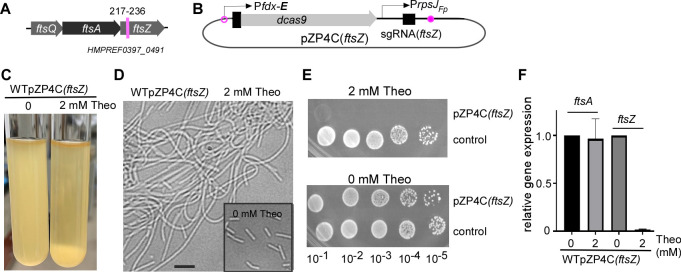Fig 4.
CRISPRi targeting essential gene ftsZ. (A) The ftsZ gene, the last gene of a three-gene operon, is depicted. The specific 20-nt base-pairing region targeted within the ftsZ gene is highlighted by a red line, along with the locus number for reference. (B) The pZP4C(ftsZ) plasmid design, specifically engineered to target the ftsZ gene. (C) CRISPRi-mediated ftsZ silencing shows most cells sedimented at the bottom of the culture tube. Wild-type cells containing pZP4C(ftsZ) were cultivated overnight in a TSPC medium with and without inducers. (D) CRISPRi-mediated ftsZ silencing causes cell filamentation. Cells from the panel C experiment were observed under a phase-contrast microscope. The inset graph shows cells from cultures grown without inducers as a control. (E) Real-time PCR confirms ftsZ-specific targeting by CRISPRi and its minimal polar effect on ftsA, the preceding gene. Total RNA, extracted from cells during the early stationary phase with or without inducers, was used for RT reactions. (F) Inhibition of growth on agar plates upon ftsZ silencing with CRISPRi. Wild-type strains with pZP4C(ftsZ) or the control plasmid (see Fig. 3Ba) were grown in a TSPC medium without inducers. After serial dilutions, samples were spotted on TSPC agar plates with or without 2 mM theophylline. Photographs of the plates were taken after a 3-day incubation.

